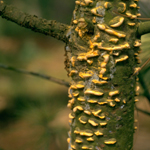
Forest Pathology
Forest pathogens are a natural part of the environment and diseases caused by these pathogens can be beneficial as well as destructive to the forest as a whole. Starting from the basis of “forest health”, this module presents an overview of the various categories of forest pathogens, as well as stand and tree level symptoms of various pathogens.
Learning Objectives
It is expected that after watching the presentation and lab videos you should have learnt the following:
- Analyze the concept of “healthy forest”.
- Explain the role of fungi in forest.
- Explain the difference between the terms abiotic, decline and biotic regarding forest diseases.
- Describe the difference between stand and tree level symptoms of diseases.
- Differentiate between the different categories of forest pathogens.
- Describe how to recognize and identify pathogens.
- Describe the symptoms and effects of white and brown rot decay fungi.
- Discuss Armillaria root disease and white pine blister rust.
Presenter
Listen to Dr. Hamelin respond to the question: How did I get interested in this area of study? by clicking on his photo.
For information about Dr. Hamelin, please check UBC, Faculty of Forestry
Module Resources
Presentations
![]() Introduction to Forest Pathology
Introduction to Forest Pathology
Dr. Richard Hamelin explains that forest health depends on user expectations, and the spatial and/or temporal scale at which forest is examined. Disease, the reaction of the tree to the biotic or abiotic disturbance, has numerous positive and fewer negative roles in forest. Forest pathogens, biotic agents which can cause the disease, can be foliar, stem, root, mistletoe, white and brown rot, native or introduced organisms.
FOREST video
 Pathology in the Forest
Pathology in the ForestIn this video, Dr. Hamelin examines forest health. Starting from the stand level, he points out symptoms of disease problems in the forest. Inside the forest there are infection centres; tree level examination reveals several signs and symptoms of laminated root disease: root balls, delamination of lignon and the mauve-coloured mycellium of Phellinus weirii. Is this forest healthy? The disease centre makes for openings in the stand canopy which allows for regeneration; the white decay fungus that breaks down the log plays an essential role in nutrient cycling.
Laboratory videos
 Pathology in the Lab: Introduction
Pathology in the Lab: IntroductionIt is not always possible to determine the pathogenic causal agent of a disease by looking ath the symptoms found in the forest; determination needs to take place in the laboratory.
 Pathology in the Lab: Pathogen Isolation
Pathology in the Lab: Pathogen IsolationPadmini demonstrates how to isolate the causal agent of a canker. Working in a sterile environment, she obtains a small piece of the canker and places it on growing medium in a petri dish. Isolation involves several cycles of sampling and sub-culturing until a pure culture of the pathogen, (Septoria musiva), is obtained. She also shows the first step in DNA identification of a pathogen excised from a leaf spot of the pathogenetic material for testing.
 Pathology in the Lab: DNA Analysis
Pathology in the Lab: DNA AnalysisStephanie demonstrates the identification, through molecular biology, of the pathogen that caused the leaf spots Padmini excised in the previous video. The extraction of the DNA involves a long protocol of initiating grinding then centrifuging and filtering the sample. The resultant pure DNA sample is put into a PCR (polymerase chain reaction) machine to generate millions of copies and identified using agral gel for visualization of the DNA.
Other Resources
- Tree Insects and Diseases of Canada’s Forests
- Agrios, G. 2011. Plant Pathology. 6th ed. Academic Press.
- Forest and Shade Tree Pathology by Dr. James Worrall, Forest Pathologist, USDA Forest Service, Rocky Mountain Region.
- Forest Pathology and Wood Microbiology Research Laboratory of Dr. Robert Blanchette, U. of Minnesota.
Potential Questions for use by Instructors
- Explain the difference between spatial and temporal scale.
- What is the difference between a pathogen and a disease?
- What are the main groups of diseases?
- Explain the difference between stand level and tree level symptoms of tree diseases. Give 2 examples of each.
- Describe a control method against root diseases. Explain the advantages and disadvantages of this method.

